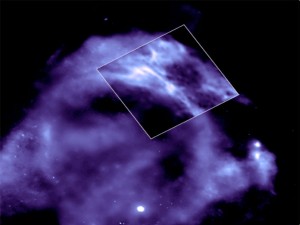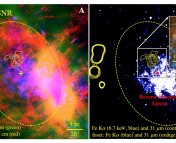- Paper title: The SN 393-SNR RX J1713.7-3946 (G347.3-0.5) Connection
- Authors: Robert A. Fensen, Richard Kremer, Daniel Patnaude, and Dan Milisavljevic
- First author’s affiliation: Department of Physics and Astronomy, Dartmouth College

Star map from Su Song, a Chinese scientist (Song Dynasty, 1092 AD). Image credit: Michael Friendly and Daniel J. Denis (York University, Toronto)
This past week we have heard quite a bit about recent discoveries from those live-blogging at the AAS meeting in Austin. Now, we are going to settle down a little and put some thought into a few astronomical occurrences that are anything but recent. Many ancient civilizations had an astonishingly accurate understanding of the night sky, such that we now have records dating back thousands of years documenting bizarre or unusual events. Some of these events consist of the appearance and disappearance of a “guest star” (the Chinese term for an unknown and temporary object). Our modern understanding is that many of these were due to transient events, such as a supernovae. One niche in astronomy combines detailed historical research with a modern understanding of astronomical phenomena in an attempt to identify the physical events to which these ancient records refer.
This particular paper examines the possible connection of a galactic supernova remnant (SNR RX J1713.7-3946) with the appearance of a guest star in the year AD 393 as listed in the records of the Chinese Jin dynasty. The term “brevity” would be an understatement when used to describe these records. As discussed in the paper, the translated text merely states that, “during the second month of the 18th year (Feb. 27 – March 28 of 393 AD) a guest star appeared within the Wei (the tail of Scorpius) and lasted until the ninth lunar month (Oct 22 – Nov. 19) when it was extinguished (or disappeared).” That’s not a whole lot to go on. So . . . how can scientists constrain whether the supernova that lead to the remnant RX J1713.7-3946 was also the event that the Chinese saw in 393?
This particular event is seen as a strong candidate for a galactic supernova event because of its long period of visibility (eight months). This is as opposed to, say, a classical nova, which is an outburst due to the thermonuclear eruption of material on the surface of a white dwarf. Classical nova typically have durations of only weeks or a few months. Thus, the first few steps are simple to understand: look for a galactic supernova remnant whose age and location (the only direct information available) are consistent with the historical record and impose the additional constraint that the supernova would have been visible on Earth with the naked eye. Currently there are nearly a dozen known galactic supernova remnants located within the tail of the constellation Scorpius. However, several properties of RX J1713.7-3946, such as its current size and expansion velocity, lead researchers to believe it is relatively young — on the order of a few thousand years — and therefore potentially consistent with the event of 393.
Additionally, the visual extinction along the line of sight to RX J1713.7-3946 is only 2 to 4 magnitudes. Although this may seem like a lot, recall that dust in the galactic plane is notorious for blocking visual light. This is in contrast to another young supernova remnant in the tail of Scorpius which is obscured by an estimated 20 magnitudes of extinction (enough to block out much of the light from even a nearby supernova). Thus, assuming a typical supernova peak absolute magnitude of around -18.0 and a distance of 1.0 and 1.3 kpc, the maximum apparent magnitude on Earth would be approximately -4.5 magnitudes, easily visible with the naked eye (for reference, Jupiter is often around -2.5 magnitudes, and the limit of the human eye at a dark sight is around +6 magnitudes). Based on these considerations, the paper tentatively associates SNR RX J1713.7-3946 with the event of 393.
However, this paper digs a little deeper. They point out that the vanishing of the guest star in the ninth month corresponds to when Scorpius would set only a few minutes after sunset in most of China, and hence no longer be visible at night. However, by examining typical light curves for various types of supernova they determine that if the 393 guest star had been a supernova of average absolute magnitude (-17 to -19, depending on type) at the location of SNR RX J1713.7-3946 it should have still been visible to the naked eye when Scorpius re-appeared approximately three months later. There is no mention of this in the Chinese records. This could be explained if the supernova associated with RX J1713.7-3946 were a significantly under-luminous supernova (-12 to -14 absolute magnitude). However, the authors argue in this case it would have been exceedingly difficult to see the supernova with the naked eye during the ninth lunar month (Oct 22 – Nov. 19) when Scorpius would only have been visible at twilight through significant atmosphere. Thus, they conclude either the supernova associated with RX J1713.7-3946 was very under-luminous and the phrase “lasted until” in the Chinese text should be interpreted as “until but not including” or the supernova remant RX J1713.7-3946 is not consistent with the guest star of AD 393.
——————
*Note: the quote in the title of this post comes from another ancient record examined in the paper. This record, also from around the year 393, came from the Romans and is quite a bit longer and more poetic. The authors conclude the Roman and Chinese records could not have been referring to the same event as Scorpius would have set before midday in Europe. Check it out for yourselves!





